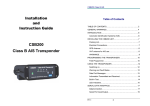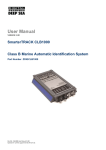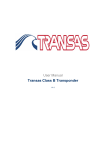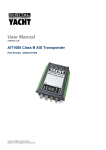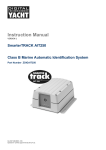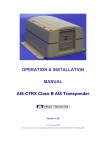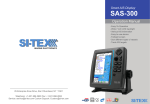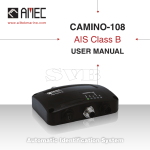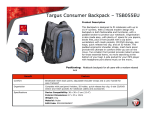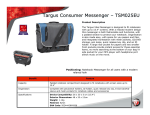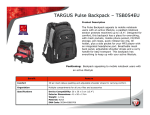Download ExNC
Transcript
ExNC extended navigation & communication ExNC 101 “Class B AIS Transponder” User Manual & Installation Manual Copyright: ExNC Entwicklungs und VertriebsgmbH Urbanstrasse 28 9554 St.Urban Austria May 2011 www.busse-yachtshop.de | [email protected] USER & INSTALLATION MANUAL ExNC ___________________________________________________________________________ extended navigation & communication Content: 1 Introduction.......................................................................................................... 3 2 Important safety and product information ............................................................ 5 2.1 General notice .............................................................................................. 5 2.2 Licensing ...................................................................................................... 6 2.3 Disclaimer .................................................................................................... 6 2.4 Responsibility of the user ............................................................................. 6 3 General................................................................................................................ 6 4 What is AIS.......................................................................................................... 7 5 Your ExNC 101 ................................................................................................... 8 5.1 Scope of delivery.......................................................................................... 8 6 Installation ........................................................................................................... 9 6.1 Installation Overview .................................................................................... 9 6.2 Radio Frequency Exposure: ......................................................................... 9 6.3 Antenna installation .................................................................................... 10 6.3.1 VHF antenna installation ..................................................................... 10 6.3.2 GPS Antenna ...................................................................................... 11 6.4 Mounting your ExNC 101 class B AIS transponder .................................... 11 6.4.1 Power .................................................................................................. 12 6.4.2 Data Connection ................................................................................. 13 6.4.3 Serial Port Input/Output....................................................................... 13 7 Programming the ExNC 101 during installation................................................. 14 7.1 Requirements............................................................................................. 14 7.2 Static Data.................................................................................................. 15 7.3 Built In Integrity Testing.............................................................................. 16 7.4 LED Indicator.............................................................................................. 16 7.5 Quiet Mode (optional)................................................................................. 17 8 Operating your ExNC 101 class B AIS Transponder ......................................... 17 9 NMEA messages............................................................................................... 18 9.1 VHF Data Link Messages........................................................................... 18 9.2 VHF data link own vessel messages (NMEA 0183 VDO) .......................... 19 9.3 Regional channel management information (ACA) .................................... 20 2 www.busse-yachtshop.de | [email protected] USER & INSTALLATION MANUAL ExNC ___________________________________________________________________________ extended navigation & communication 1 Introduction Thank you for choosing the ExNC 101 Class B AIS transponder. Your new ExNC 101 is a high quality AIS class B transponder designed and manufactured according to the latest standards and technologies It is recommended to read this manual and safety instructions carefully before installation and operation of the ExNC 101 AIS Class B transponder! The system allows you to transmit your own data as vessel’s name, call sign, MMSI, position, speed and course at any time to all other AIS equipped participants within your AIS VHF range. At the same time your AIS system receives all AIS data in your AIS VHF range, which can be displayed on your PI, e.g. ECDIS, ENC or PC, having the appropriate software installed. Today all international vessels bigger than 300 GT are required to carry class A AIS transponder systems. Many countries have already installed AIS base station ashore side and help to improve safety at sea. Please note that not all vessels are equipped with AIS systems and might not detect your AIS system! 3 www.busse-yachtshop.de | [email protected] USER & INSTALLATION MANUAL ExNC ___________________________________________________________________________ extended navigation & communication Glossary ACA ACK ALR AtoN AIS BIIT BNC COG CSTDMA CONFIGURATOR CSTDMA DC DGNSS DGPS DSC EEPROM ETA ExNC FSK GALILEO GLONASS GNSS GMSK GPS HF IMO IEC LED LNA MMSI NM NMEA PC PI RF RTCM RX SOG SOLAS SOTDMA SRM TDMA TNC TX UTC VDM VDO VHF VTS VSWR (AIS) Regional Assignment Channel Assignment Message Acknowledgement (AIS) Alarm Message Aids to Navigation Automatic Identification System Built In Integrity Testing Bayonet fitting type RF connector Course over Ground Carrier Sense Time Division Multiple Access Configuration Software Carrier Sense TDMA Direct Current Differential Global Navigation Satellite System Differential Global Positioning System Digital Selective calling Electrically Erasable Programmable Read Only Memory Estimated Time of Arrival ExNC Entwicklungs- und VertriebsgmbH Frequency shift keying European equivalent to GPS Global Navigation Satellite System Global Navigation Satellite System Gaussian Minimum Shift Keying Global Positioning Satellite / System High Frequency International Maritime Organization International Electro technical Commission Light Emitting Diode Low-noise amplifier Maritime Mobile Service Identity Nautical Mile = 1852 m National Marine Electronics Association Personal Computer Presentation Interface Radio Frequency Radio Technical Commission for Maritime Services Commission Receive or Receiver Speed over Ground Safety Of Life At Sea Self Organized Time Division Multiple Access. Safety Related Message Time-division Multiple Access Threaded type BNC connector Transmit or transmitter Universal Time Co-ordinated AIS - VHF Data Link Messages AIS - VHF data link own vessel messages Very High Frequency Vessel Traffic Services Voltage Standing Wave Ratio 4 www.busse-yachtshop.de | [email protected] USER & INSTALLATION MANUAL ExNC ___________________________________________________________________________ extended navigation & communication 2 Important safety and product information Your ExNC 101 AIS Transponder is an electrical equipment and you shall operate it with accurate caution. Improper use and handling may cause electrical shock, personal injuries or fire. • • • • • • • ELECTRICAL SHOCK HAZARD RNING WARNING DO NOT DISASSEMBLE OR MODIFY THIS EQUIPMENT TURN OFF POWER IMMEDIATELY IN CASE OF SMOKE OR FIRE OF THE UNIT PLEASE AVOID DIRECT CONTACT WITH WATER DO NOT TOUCH THE EQUIPMENT WITH WET HANDS DO NOT OPEN THE UNIT UNAUTHORIZED OPENING WILL INVALIDATE YOUR WARRANTY This product does not contain any user serviceable parts. Ask your authorized dealer for service and repair! 2.1 General notice Any AIS transponder requires a Global Navigation Satellite System (GNSS) system such as e.g. GPS or GLONASS to determine position. The accuracy of these systems is variable and can be affected by factors such as the • positioning of the antenna, the • number of satellites available to determine a position and • for how long satellite information has been received. It is recommended as often as possible to verify both your vessel’s AIS derived position data and other vessels AIS derived position data with visual or radar based observations. The VHF antenna must be connected to your transponder before powering the unit to prevent possible damage to your AIS transponder. This ensures that once transmitting the power output to the antenna port is dissipated properly. Your AIS transponder and the antenna connected emit radio frequency and electromagnetic energy. Please observer the guidelines in this manual. Safe compass distance Install your AIS class B equipment minimum 1 m (40 in.) away from any compass. Please check your compass after installation of the AIS transponder to verify that it operates accurately. 5 www.busse-yachtshop.de | [email protected] USER & INSTALLATION MANUAL ExNC ___________________________________________________________________________ extended navigation & communication 2.2 Licensing Important: Please note that in most countries the operation of an AIS transponder is under the VHF radio licence provisions. To install and operate an AIS transponder on a vessel it requires a valid VHF radiotelephone licence which lists the AIS system and the vessel Call Sign and MMSI number. Contact the relevant authority in your country for more information! 2.3 Disclaimer ExNC cannot be made liable for any accident or damage caused by or during the installation or operation of the ExNC 101 class B AIS system. The use of the system is by the operators’ risk. An AIS system is considered as a supplementary tool and does not substitute proper lookout at any time or your education as accurate seafarer as requested in the country you are sailing. ExNC shall not be made liable for any specific, direct or indirect, incidental or consequential damages out of the use of its products or publications. 2.4 Responsibility of the user The user shall be responsible to observe governmental regulations. The class B AIS transponder is operating in dedicated maritime frequencies. These frequencies shall be included in your ships license. A special license might be required when the AIS unit is operated on land. 3 General From time to time upgrades of the hard- and software of this product are made. Future versions may therefore not correspond to this manual exactly. When necessary upgrades to the product are made, these will be accompanied by updates or addenda to this manual. Information contained in this manual is liable to change without notice. Although ExNC strives for accuracy in this publication, this manual or other documentation provided with this product can contain errors or have omissions, and is subject to change without prior notice. 6 www.busse-yachtshop.de | [email protected] USER & INSTALLATION MANUAL ExNC ___________________________________________________________________________ extended navigation & communication 4 What is AIS The Automatic Identification System is a short range VHF based system used on ships and by Vessel Traffic Services (VTS) for identifying and locating vessels by electronically exchanging data with other nearby ships equipped with AIS and VTS base stations operated by authorities. The range of your AIS system is depending on various factors like the height of the VHF antenna mounted, weather conditions, etc. In general the coverage can be up to 25 miles. AIS is intended to enhance safety for life at sea, improve safety and efficiency in navigation and protect the marine environment by assisting the vessel's watch standing officers. The information (data) AIS is exchanging consists basically of 3 types: • static data: these data have been programmed to your AIS during installation o MMSI, o call sign, o name of your vessel, o length and beam + reference for position. These data are fixed and needs to be changed only when your vessel changes flag, name or its size during refit. • dynamic data: these are deriving from your GNSS system or sensors (e.g. Gyro) and calculated by your AIS transponder: o Position, o SOG, o COG, o navigational status (entered manually), o UTC. • voyage related data: are entered manually (only for AIS class A systems) and do not apply for class B AIS transponders. All these data can be displayed on a PI like PC, ECDIS, ENC. The 4 “s”: AIS is used in a ship-to-ship mode for collision avoidance and safety awareness. Due to the limitations of VHF radio communications, and due to the fact that not all vessels are equipped with AIS, it does not replace proper lookout. It is a supporting tool only! AIS is used in a ship-to-shore mode as a means for littoral States to obtain information about vessel sailing its territory. VTS are operating AIS land stations to monitor their area and for traffic management SAR operators are using AIS to identify relevant vessels and their status. 7 www.busse-yachtshop.de | [email protected] USER & INSTALLATION MANUAL ExNC ___________________________________________________________________________ extended navigation & communication AIS uses marine dedicated VHF channels with frequencies set from 156.025 MHz to 162.025 MHz. AIS transponders are using time slots (2250 per minute) to transmit data packages. The whole broadcasting process is done automatically and does not require any manual operation. The AIS network is designed for use with certified AIS systems only. The reporting rate of your Class B AIS systems based on CSTDMA is according to the following table: Platform: Class B AIS (CSTDMA) SOG ≤ 2 knots SOG > 2 knots report rate by command of VTS 5 5.1 Reporting interval 3 minutes 30 seconds up to 5 seconds Your ExNC 101 Scope of delivery The package contains 1 ExNC 101 Class B AIS transponder 1 User and installation manual 1 CD Configurator Software (optional by e-mail) 1 1,5 m data and power cable with SUB D 15 plug to connect with power, PC or ECDIS 1 Mounting bracket 1 GPS/VHF antenna (combined) with 5 m antenna cable (optional). 8 www.busse-yachtshop.de | [email protected] USER & INSTALLATION MANUAL ExNC ___________________________________________________________________________ extended navigation & communication 6 6.1 Installation Installation Overview GPS antenna VHF antenna Combined GPS/VHF antenna ExNC 101 10 – 30 VDC ECDIS, ECS, PC The ExNC 101 works as a black box system and can be interfaced to ECS, ECDIS or any other charting system computing AIS data and visualizing the AIS traffic within your AIS range. 6.2 Radio Frequency Exposure: In order to meet the requirement for Radio Frequency Exposure it is strongly recommended to keep safety distances to electrical equipment that can interfere with your AIS system: X-Band Radar antenna Satellite communication ant VHF or HF antennas High power sources, cables 1,5 m (5 ft) 4,0 m (13 ft) 3,0 m (10 ft) 1,0 m (3 ft) The compass safety distance of this unit is 1 m (40 in.) or greater for 0.3° deviation 9 www.busse-yachtshop.de | [email protected] USER & INSTALLATION MANUAL ExNC ___________________________________________________________________________ extended navigation & communication 6.3 Antenna installation 6.3.1 VHF antenna installation Please make sure that the antenna used with your ExNC 101 is a marine band antenna having following characteristics: • • • • • Frequency band from 156.025 to 162.025 MHz Antenna type: Vertical radiator Impedance: 50 Ohm Antenna gain: 0-3 dBi with a bandwidth sufficient to maintain VSWR < 1,5 over the frequency band Connector type: SMA The best spot to place the VHF antenna is high above sea level. The height of your antenna influences the range of your transceiver. Place the antenna at least 3 m away from any other VHF antenna and give them different heights. Allow the antenna a clear 360° view to have the best performance. Concerning your own and your passengers’ safety mount the VHF antenna at least 3m above any person standing on deck to meet safety directives on Maximum Permissible Exposure (MPE) / Specific Absorption Rate (SAR). Run the antenna cable at the shortest way to your transponder to avoid any signal loss. All connectors need to be properly terminated and sealed to avoid humidity, signal losses, and reduced functionality. WARNING Leaving the VHF antenna port disconnected, or shorting the VHF antenna port will activate the VSWR alarm and causes the unit to stop transmitting position reports and can cause damage to your transponder. 10 www.busse-yachtshop.de | [email protected] USER & INSTALLATION MANUAL ExNC ___________________________________________________________________________ extended navigation & communication 6.3.2 GPS Antenna The GPS antenna must be suitable for marine shipboard applications and shall have following minimum performance characteristics: • • • Type: active 3.3 V Impedance: 50 Ohm Connector type: SMB The GPS antenna is dedicated for the AIS transponder only and used for time synchronisation and position of your AIS transponder. Install the GPS antenna with “clear view to the sky”. Any obstructions may influence the proper usage of your class B AIS system. GPS signals are vital for the operation of your AIS transponder (i.e synchronisation of time slots) and cannot be shared with any other GPS receivers. Instead of single GPS and VHF antenna you can also opt for a combined VHF/GPS antenna. The recommendations and safety instructions will remain the same. Properly connect both your antennas to your ExNC 101 unit. 6.4 Mounting your ExNC 101 class B AIS transponder The ExNC 101 is a black box system with 4 status LEDs and IP 65 proofed case. Please protect it from water and spray. Important: The ExNC 101 unit is designed for operation in a temperature range from -25 °C to +55 °C. Do not install (or use) the unit in environ ments exceeding this range! Install the system on your bridge and make sure no other transceivers are in its vicinity. The minimum distance to any other transceiver should be 1 m. Power lines should not lie across your transponder. Use the mounting bracket delivered with your system or any other appropriate mounting facility. 11 www.busse-yachtshop.de | [email protected] USER & INSTALLATION MANUAL ExNC ___________________________________________________________________________ extended navigation & communication Your transponder is equipped with a SUB-D 15 male plug incorporating power and data connection. Pin 8 Pin 15 1 2 3 4 5 6 7 8 9 10 11 12 13 14 15 Pin 1 Pin 9 Interface connector Pin description (female) GND Power Vcc Power I/O Digital Input or Output (optional) GND RS 422 RS 422 (optional) Not used GND RS 232 RS 232 Rx RS 232 RS 232 Tx RS 232 RS 232 Not used 5 V ext. Reserved (optional) I/O Digital Input or Output (optional) Rx B RS 422 (optional) Rx A RS 422 (optional) Tx B RS 422 (optional) Tx A RS 422 (optional) Connector housing is connected to chassis ground! 6.4.1 Power The unit can be powered with 10-30 VDC and should have 2 ampere peak to the power lead. Once power is on the LED indicator turns green. Warning: Do not connect the ExNC 101 to any main AC power source. It could result in electric shock and fire hazard. Do not connect the ExNC 101 to a DC power source exceeding 30 VDC. It might result as damage to the unit. Do not reverse the supply polarity. Now you can connect the ExNC 101 to your ECDIS or ENC chart system or your PC via the SUB-D-15 connector. 12 www.busse-yachtshop.de | [email protected] USER & INSTALLATION MANUAL ExNC ___________________________________________________________________________ extended navigation & communication 6.4.2 Data Connection The power/data cable is a 15-pin D-type female connector with which you can connect your ExNC 101 via RS 232 or RS 422 to an external display unit (e.g. chart plotter, PC, ENC, ECDIS) visualizing other AIS units within range. Please check with the supplier of your ECDIS, ENC or PC software and make sure that the same is able to compute AIS data. The software of your ExNC 101 delivers you automatically AIS data on the interface. The baud rate is fixed to 38400 bps with 8 data bits, one stop bit and no parity. No handshake is used. VDM, VDO, ACA, TXT messages conform to NMEA 0183. 6.4.3 Serial Port Input/Output There are two serial ports provided. One is in RS 232 and one in RS 422 format (optional). Data input can be done through both ports. The serial port interface(s) output: • As a VHF Data Link Message (VDM) all incoming VHF Data Link (VDL) data received by your transponder. • The VHF data link own vessel (VDO) messages sent by your transponder over the VHF Data Link. • AIS regional channel assignment messages (ACA) received. These are derived from an incoming VHF Data Link message (message 22) or a DSC message. • Text messages (TXT). 13 www.busse-yachtshop.de | [email protected] USER & INSTALLATION MANUAL ExNC ___________________________________________________________________________ extended navigation & communication 7 Programming the ExNC 101 during installation Before you can use your ExNC 101 AIS class B transponder it needs to be programmed with the individual information about your vessel, which will be transmitted continuously and autonomously. The static data comprises: - Name of the vessel Call sign of the vessel MMSI number of the vessel Dimensions of the vessel Position of the GPS antenna The software CD “ExNC 101 CONFIGURATOR*” is computing settings and resettings of your transponder. Your certified dealer will do the programming for you. The settings are stored in an EEPROM and can be changed and/or deleted only by the appropriate dealer. Loose of power do not influence the settings * The CONFIGURATOR uses components and source code developed by other companies or groups. Microsoft .Net Framework: Copyright © 2005 Microsoft Corporation. All trademarks mentioned in this document are the property of their respective owners. 7.1 Requirements The “CONFIGURATOR” is designed to operate with Microsoft Windows XP and above. Recommended minimum system requirements are: • Microsoft Windows XP • At least one RS232 serial port (or USB to serial converter*) * When using an USB to serial converter please ensure this is fully installed before proceeding. This Configurator software uses the Microsoft .Net Framework. The Framework will be automatically installed during setup of the CONFIGURATOR. 14 www.busse-yachtshop.de | [email protected] USER & INSTALLATION MANUAL ExNC ___________________________________________________________________________ extended navigation & communication 7.2 Static Data All data fields must be completed and saved to the ExNC 101. The MMSI number must be entered 2 times to verify it is correct. Attention: For security reasons the MMSI of the vessel cannot be changed once programmed! Do not program the MMSI unless you are absolutely sure you have the correct information. Please check the number entered carefully. If the MMSI programmed is incorrect the AIS transponder needs to be returned to the supplier for factory reset. If no MMSI is entered (MMSI is set to 000000000 by default) the ExNC 101 transponder will not transmit any data and operate in receive only mode. The red LED will remain on and you will not be received by any other AIS station. An MMSI must be entered to allow the AIS transponder to transmit its own data to other vessels. Vessel’s name: enter the name of your vessel (max. 20 characters) Call sign: enter the call sign of your vessel (max.7 characters) MMSI number: enter the MMSI number (9 digits) of your vessel and repeat Dimension: enter your vessel’s dimensions rounded to the nearest meter Dimension A: distance from bow to GPS antenna location Dimension B: distance from the GPS antenna location to the stern Dimension C: distance from the port side to the GPS antenna location Dimension D: distance from the GPS antenna to the starboard side Select the most appropriate vessel type from the drop down menu. When entered all data correct, safe the static data by pressing the safe button to the ExNC 101 AIS class B transponder CONFIGURATOR. Now your transponder is programmed and ready for usage. 15 www.busse-yachtshop.de | [email protected] USER & INSTALLATION MANUAL ExNC ___________________________________________________________________________ extended navigation & communication 7.3 Built In Integrity Testing Your ExNC 101 unit is equipped with Built In Integrity Testing (BIIT). The BIIT shall run continuously or at appropriate intervals simultaneously with the standard functions of the equipment. Tests include: • AIS TX malfunction (synthesiser not locked and TX time-out not exceeded) • Antenna VSWR exceeds limit • Rx channel 1 malfunction (synthesiser not locked) • Rx channel 2 malfunction (synthesiser not locked) • Internal GNSS not in use • No valid SOG information • No valid COG information • Background noise > -77dBm • GPS failure 7.4 LED Indicator Green LED: shows status of the power connected to your transponder and flashes continuously when the unit is powered correctly. Yellow LED: on continuously: it indicates that your transponder is not allowed to transmit. Reason can be Tx timeout: if the unit has not transmitted a position report during the last two reporting intervals (nominal reporting interval can not be maintained for operational reasons, for example Message 23 quiet period, high VDL load); mmsi is not configured blinking: Silent Mode is activated Blue LED: indicates that a safety related message has been received. Red LED: when on continuously it shows that the GPS is unable to gain lock! Please check your GPS antenna and the connections. 16 www.busse-yachtshop.de | [email protected] USER & INSTALLATION MANUAL ExNC ___________________________________________________________________________ extended navigation & communication 7.5 Quiet Mode (optional) You can put your ExNC 101 into “silent” mode and transmitter will stop to transmit data on the VHF data link. Your transponder will receive data from other AIS systems only. Please note that in this mode you are not visible for other AIS participants. ExNC has realized the quiet mode as hardware solution and it will be connected as a switch through your SUB D 15 plug. 8 Operating your ExNC 101 class B AIS Transponder Your transponder has 4 LED indicators showing the status of your AIS system. This system is complementary to your radar system (in case of rain, snow and sea clutter conditions) and electronic chart system if available. Safety will be improved during navigation at night or restricted visibility and land obstacles. Some Maritime Authorities are transmitting safety related messages via land based AIS networks. These AIS messages are including information about threats in fairways, navigational warnings, meteorological data like wind speed, water level, currents, tides etc… AIS Class A Transponders will transmit the following data that can be received from your ExNC 101 class B AIS system: Static Information • Name • Type of vessel • Call sign • MMSI number • IMO number • Size of vessel Dynamic Information • Position • Speed Over Ground • Course Over Ground • Rate Of Turn • Heading Voyage related Information • Destination • Depth • ETA • Navigational Status Any Class B AIS Transponders will transmit the following data that can be received from your ExNC 101 class B AIS system: Static Information • Name • Type of vessel • Call sign • MMSI number • Size of vessel Dynamic Information • Position • Speed Over Ground • Course Over Ground • Heading Voyage related Information • None Note: Not all transponders (class A and class B) are programmed accurately and information can be missed according to the above table. 17 www.busse-yachtshop.de | [email protected] USER & INSTALLATION MANUAL ExNC ___________________________________________________________________________ extended navigation & communication 9 9.1 NMEA messages VHF Data Link Messages Receiving a VHF Data Link (VDL) message on either AIS radio channel causes a VDM message presented at the data port. Please see ITU-R M. 1371-3, Annex 8 for a list of messages. VDM Message Format !--VDM,x1,x2,x3,a,s--s,x*hh<CR><LF> • x1 = Total number of sentences needed to transfer the message, 1 to 9 • x2 = Sentence number, 1 to 9 • x3 = Sequential message identifier, 0 to 9 • a = AIS Channel, "A" or "B" • s - - s = Encapsulated ITU-R M.1371 radio message • x = Number of fill-bits, 0 to 5 VDM Message Types For example, the information contained in the s - - s section of the VDM = Encapsulated ITU-R M.1371 radio message. Note that messages 19 may be sent as multi part messages using the x1, x2 and x3 parameters for a message sequence control. Excerpt from ITU-R M. 1371-3, Annex 8 Message ID VDM message description AIS Target Display Information 1 Scheduled position report, class A 2 Assigned scheduled position report, class A 3 Special position report, response to interrogation, class A 4 Base station report (position, UTC, date and current slot number 5 Scheduled static and voyage related data, class A 9 Position report for airborne stations involved in SAR operation 18 Standard position report of class B ship-borne equipment 19 Extended position report for class B AIS 21 Position and status report for AToN 24 Class B CS static data Safety message handling 12 Safety related message for addressed communication 14 Safety related data for broadcast communication External message handling 8 Binary data for broadcast communication (optional Rx) System control 11 Current UTC and date if available (optional Rx) 15 Request for a specific message type 17 DGNSS corrections provided by a Base Station (optional Rx) 20 Reserve slots for Base Stations 18 www.busse-yachtshop.de | [email protected] USER & INSTALLATION MANUAL ExNC ___________________________________________________________________________ extended navigation & communication 22 23 Management of channels and transceiver mode by Base Station Group assignment 9.2 VHF data link own vessel messages (NMEA 0183 VDO) It describes the message sent by your own vessel. VDO Message Format !--VDO,x1,x2,x3,a,s--s,x*hh<CR><LF> Where • x1 = Total number of sentences needed to transfer the message , 1 to 9 • x2 = Sentence number, 1 to 9 • x3 = Sequential message identifier, 0 to 9 • a = AIS Channel, "A" or "B" • s - - s = Encapsulated ITU-R M.1371 radio message 4 • x = Number of fill-bits , 0 to 5 Message ID VDO message description AIS Target Display Information 13 Acknowledgment of received SRM (optional Tx) Standard position report for class B AIS including MMSI, SOG, 18 position accuracy, lat, long, COG, true heading,) Extended class B position report (transmits only as response to 19 base station interrogation) 24 A Static data report: MMSI + Name Static data report: MMSI + Static Data (type of vessel, CS, 24 B dimension) 19 www.busse-yachtshop.de | [email protected] USER & INSTALLATION MANUAL ExNC ___________________________________________________________________________ extended navigation & communication 9.3 Regional channel management information (ACA) Your transponder is able to receive regional channel management information (ACA) in two ways: • ITU-R M.1371 message 22 or a • DSC telecommand received on channel 70, ACA Message Format $--ACA,x,llll.ll,a,yyyyy.yy,a,llll.ll,a1,y1y1y1y1y.y1y1,a2,x1,x2x2x2x2,x3,x4x4x4x4, x5,x6,x7,a3,x8,hhmmss.ss*hh <CR><LF> • x = Sequence Number , 0 to 9 • IIII.II, a = Region Northeast corner latitude – N/S • yyyyy.yy,a1 = Region Northeast corner longitude – E/W • llll.ll, a = Region Southwest corner latitude – N/S • y1y1y1y1y1.y1y1,a2 = Region Southwest corner longitude – E/W • x1 = Transition Zone Size • x2x2x2x2 = Channel A • x3 = Channel A bandwidth • x4x4x4x4 = Channel B • x5 = Channel B bandwidth • x6 = Tx/Rx mode control • x7 = Power level control • a3 = Information source • x8 = In-Use Flag • hhmmss.ss = Time of "in-use" change Although ExNC strives for accuracy in all its publications, this material can contain errors or have omissions. This manual is subject to change without prior notice. ExNC shall not made liable for any specific, direct or indirect, incidental or consequential damages out of its use. 20 www.busse-yachtshop.de | [email protected] USER & INSTALLATION MANUAL ExNC ___________________________________________________________________________ extended navigation & communication DECLARATION of CONFORMITY Certifying organistion: ExNC Entwicklungs- & VertriebsgmbH Urbanstrasse 28 9554 St.Urban Austria Declare under own responsibility that the product: Product description: Product type: Product variants: Brand name: ExNC 101 Class B AIS Transponder PCB PCB only and all ExNC 101 in enclosures -ExNC 101 to which this declaration relates, conforms to the essential requirements and other relevant stipulations of the R&TTE directive 1999/5/EC. The products conform to the following norm(s) and/or one or several normative standards and documents: IEC 60945 IEC 61162-1/-2 IEC 62287-1 IEC 61108 ITU-R M.1371-2 Technical data are available and can be obtained on request. St.Urban, 1st of August 2010 ExNC Entwicklungs- & VertriebsgmbH 21 www.busse-yachtshop.de | [email protected] USER & INSTALLATION MANUAL ExNC ___________________________________________________________________________ extended navigation & communication 22 www.busse-yachtshop.de | [email protected]






















